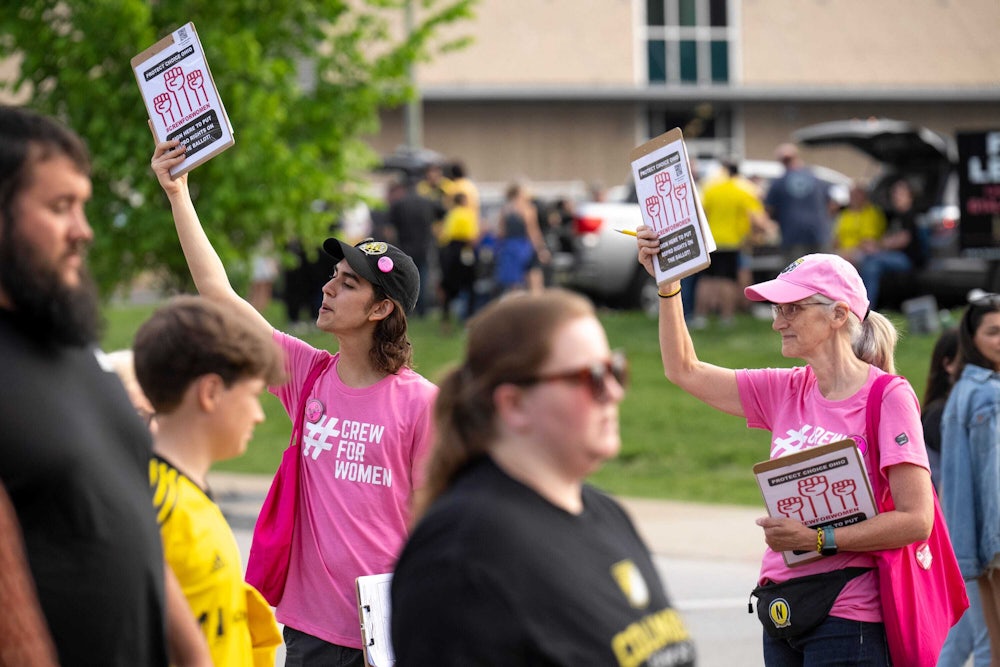For much of this year throughout Ohio, it seemed like you couldn’t go to a coffee shop, community event, or leave the local Kroger without someone with a clipboard asking if you’d signed a petition to get protections for reproductive rights on the ballot. After Roe v. Wade was struck down last year, a broad coalition of groups—including a range of reproductive rights groups, the ACLU of Ohio, and physicians—began a grassroots effort that swept across the state to put Ohioans’ right to abortion on the November ballot.
In this once-purple state turned mostly red, where Donald Trump won twice, almost 60 percent of voters still support a potential amendment to protect reproductive rights, including abortion. But Ohio is also a complex state that sometimes feels uniquely subject to political shadiness. Now Republican leaders are trying out a new barrage of tricks to make it harder for voters to have their voices heard—or even understand the basics of the decisions presented on their ballots.
At issue is the ballot measure meant to enshrine reproductive rights in the state’s constitution, which would ensure reproductive health care protections for Ohioans in a post-Roe world. For months, state Republican leaders have tirelessly worked to stymie the measure—which has mobilized left-leaning, independent, and center-right women voters—most recently, advocates say, by attempting to mislead voters at the ballot box.
As a case filed last week with the Ohio Supreme Court by Ohioans United for Reproductive Rights asserts, Ohio’s GOP-led Ballot Board at a meeting last month unlawfully reworded Issue 1, the ballot measure meant to enshrine reproductive rights in the state’s constitution, in order to “mislead, deceive, and defraud” voters. In short, the lawsuit claims the new language—what voters will read on their actual ballots—fails to align with the proposed amendment in terms of impartiality, accuracy, or completely describing the amendment’s effects.
This is not the first time the state GOP has tried to waylay Issue 1. But now the battle over reproductive rights is coming to a head this election season in a fight over whether to allow voters to simply read, from the comfort of their voting booth, the truth about the amendment they’re actually voting on.
On June 25, 2022, just hours after the U.S. Supreme Court’s Dobbs decision, a federal judge lifted an injunction that had been blocking a 2019 Ohio law banning abortion as early as six weeks’ gestation—effectively making it next to impossible for Ohioans to get an abortion. Often called the “Heartbeat Act,” the 2019 law, which had no exceptions for rape or incest, criminalized all abortions performed after fetal cardiac activity (not an actual heartbeat) could be detected. This is a point before many people even realize they are pregnant. Providers could face a fifth-degree felony charge and a year in prison. Polling shows that the majority of Ohioans are in opposition to the six-week ban.
“We went from being a state where our patients could get the care that they needed to [a] state with a really severe abortion ban within hours of the Dobbs decision, without any transitional period or preparation,” Lauren Beene, a Cleveland pediatrician and executive director of Ohio Physicians for Reproductive Rights, told me. She said she knew doctors who were working in clinics or on call when they learned about the change in law. “The care they had been planning to provide … was now illegal.”
The Monday after Dobbs, Beene went to work and heard from the mother of a 13-year-old patient who was not sexually active. The mother called and asked if her daughter should go on birth control. “What if she was raped and got pregnant?” Beene remembers the mother asking. One of Beene’s other patients at the time was a 16-year-old who was roughly eight weeks pregnant; the teen had been trying to decide whether to continue her pregnancy. After the decision, Beene recalled, “I had to call her and say, you know, hey, if you are thinking about having an abortion, you can’t wait to have that conversation with the O.B. You have to go back to the abortion clinic today. And in fact, it might already be too late.”
Beene wrote an open letter to patients, thinking if she shared a physician’s perspective that might help explain the dangers of Ohio’s new trajectory. She posted it in a Facebook group for other doctors, which is where she met Marcella Azvedo, a pulmonologist and critical care doctor, who suggested starting a separate Facebook group to see if they could get other doctors involved. Soon, 1,000 physicians signed the letter, which they published in July as a full-page ad in The Columbus Dispatch.
Since Roe v. Wade was struck down, the battle over abortion in Ohio has made a winding path through the courts: The six-week abortion ban was eventually blocked by more injunctions, making abortion currently legal in Ohio up to about 22 weeks. But it’s inevitable that the fight will one day make its way to the right-leaning Ohio Supreme Court. Advocates like Beene felt the need to act fast.
“We felt that if we didn’t take action to get a constitutional amendment on the 2023 ballot, we knew that that six-week ban would most certainly go back into effect and we would reenter that crisis,” Beene said. “This just couldn’t wait until 2024—or at all.”
A team consisting of physicians and other medical professionals, plus constitutional and election attorneys—a group whose respective organizations later evolved into a coalition called Ohioans United for Reproductive Rights—began hashing out language for a potential amendment. Soon the coalition mobilized volunteers across the state to gather petition signatures. One of its groups, Ohioans for Reproductive Freedom, paid some professional circulators in order to gather more. (Advocates clarify that the vast majority of folks out this spring with petitions were volunteers.)
After months of canvassing, in July 2023, the broad coalition together submitted over 700,000 signatures to the Ohio secretary of state’s office, a figure representing one in 11 Ohio voters. The measure garnered more than enough signatures to earn a spot on the November ballot.
But a last-ditch effort was already underway to undermine the November reproductive rights vote. Alarmed by the amount of mobilization around abortion, Republican lawmakers pushed forward a special August election in an attempt to get Ohioans to raise the threshold for constitutional amendments to a 60 percent supermajority of votes and raise the minimum requirement to get a citizen-driven amendment on the ballot. It was a clear attempt to make the passage of the abortion amendment harder. Secretary of State Frank LaRose openly stated in June that blocking the November abortion rights measure was “100 percent” the motivation behind the August special election. Throughout the summer, Ohioans were bombarded with conflicting and confusing messages fueled by roughly $35 million in funds from both sides dumped in from out of state.
The Ohio Senate had to allocate $15 million to cover costs for running the special election—but after all those dollars were spent, voters rejected the August initiative by a 57 to 43 percent margin. The November abortion amendment would be decided by a simple majority of Ohio voters.
However, just weeks after that attempt failed, on August 24, Ohio’s Ballot Board met to finalize the language that would appear on voters’ November ballots for the reproductive rights issue. LaRose, who chairs the board, explained his office had drafted new ballot language. “Having worked extensively on drafting this, I do believe it’s fair and accurate,” LaRose said.
The new ballot “summary” of the amendment, as proposed by LaRose, is longer than the actual amendment and pulls several rhetorical tricks on the reader. The amendment would guarantee the right of a person to continue their pregnancy and protects that decision from state interference (the choice would be protected, even when doing so may impact the person’s life or health). But the new ballot language erroneously flips this, claiming the amendment would “always allow an unborn child to be aborted … if, in the treating physician’s determination, the abortion is necessary to protect the pregnant woman’s life or health.”
The amendment also protects multiple categories of reproductive decisions, including contraception, fertility treatment, continuing a pregnancy, miscarriage care, and abortion, but the altered ballot language only lists abortion. While the amendment uses the medical term “fetus,” the new ballot language has substituted “unborn child,” phrasing that inserts personal views regarding the beginning of life. It’s also a term that was never used in the petitions to get the issue on the ballot.
“The Ballot Board’s members adopted politicized, distorted language for the amendment, exploiting their authority in a last-ditch effort to deceive and confuse Ohio voters ahead of the November vote on reproductive freedom,” Lauren Blauvelt, spokesperson for Ohioans United for Reproductive Rights, said in a statement.
Just hours after chairing the meeting that changed the ballot language, Secretary LaRose tweeted a factually misleading statement: “The radical left wants to amend Ohio’s constitution to allow abortion on demand up to the moment of birth.” In fact, after the point of fetal viability, the amendment would authorize the state to restrict abortion or prohibit it outright, but with an exemption to protect the life or health of the pregnant person.
It’s one thing to tweet deceptions. It’s another thing to bake them into the ballot. Ohio’s constitution requires ballot language to “properly identify the substance of the proposal to be voted on.” Politics is supposed to be left out of the process.
During the Ohio Ballot Board meeting, LaRose did note that the full text of the amendment would be available at each polling place on a poster and would be published in newspapers. But alone in the voting booth, many Ohioans will be reviewing the amendment language for the first time—and likely not thinking to look around for alternative phrasing on a poster. Unless the Ohio Supreme Court intervenes, voters will be reading LaRose’s version.
Beene said that she and others involved in writing the amendment feel the new ballot language “is just complete political propaganda that is designed to deceive the voters and mislead the voters.
“We feel that the people of Ohio should be able to read the actual amendment,” she said.










